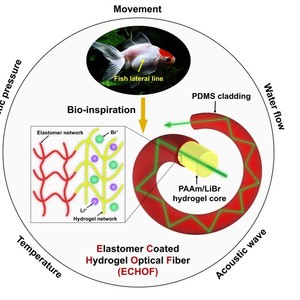Interface Deformable, Thermally Sensitive Hydrogel–Elastomer Hybrid Fiber for Versatile Underwater Sensing
Citation
Chengmin Wang, Baohu Wu, Shengtong Sun*, and Peiyi Wu*. Interface Deformable, Thermally Sensitive Hydrogel–Elastomer Hybrid Fiber for Versatile Underwater Sensing. Adv. Mater. Technol. 2020, 5, 2000515.
Abstract
Underwater sensing plays a vital role in perceiving various hydrodynamic stimuli for underwater operations, while fishes evolve an adaptable, durable, and multifunctional lateral line sensory system to feel mechanical deformations from nearly all sources as well as water temperature changes. Such perfect integration of multiple functions into one biological system poses a great challenge for artificial soft sensors. Here, by constructing a stretchable and water‐proof core‐cladding hydrogel–elastomer hybrid optical fiber, nearly all the underwater sensations of fish lateral lines can be realized with unprecedented sensing stability. High‐refractive‐index salt, LiBr, is introduced to the hydrogel core to enable long‐range light propagation with a low loss coefficient (≈0.32 dB cm−1), and the dissimilar yet tightly adhered hydrogel–elastomer interface is readily deformable, contributing to the ultrasensitive optical response to subtle environmental stimulations, induced by either motions, hydrostatic pressure variations, ultrasonic/audible sound waves, or water flows. Moreover, the optical loss of the hybrid fiber is linearly responsive to wide temperature changes (5–70 °C), caused by the altered light scattering from hydrogel chain clustering. The present elastomer–hydrogel hybrid optical fiber offers a new designing strategy in developing next‐generation underwater stretchable ray‐optic sensors.


